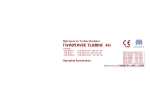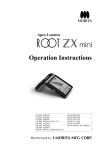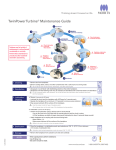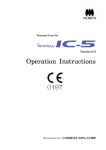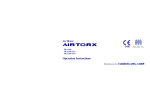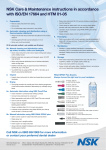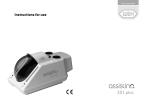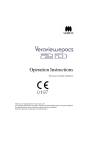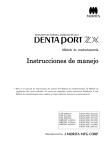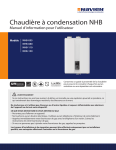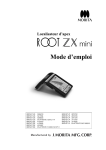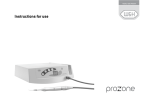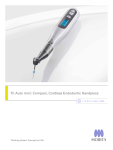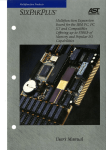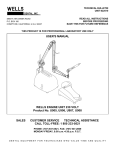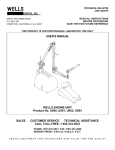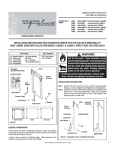Download Autoclave Procedure Follow steps 1~9
Transcript
High Speed Air Turbine Handpiece <with light> PAR-4HEX-O PAR-4HX-O PAR-4HMX-O PAR-4HEX-O-KV / WH / SR / NK PAR-4HX-O-KV / WH / SR / NK PAR-4HMX-O-KV / WH / SR / NK Operation Instructions US PAT. US PAT. US PAT. DE PAT. DE PAT. 5902108 6676374 7048540 19807566 19860953 JP PAT. JP PAT. JP PAT. JP PAT. 3208345 3672781 3795722 3897953 This manual covers the TWINPOWER TURBINE 4H series handpieces which can be connected to Morita couplings CP4-O/WO and other manufacturer’s couplings. PAR-4HEX-O*1, PAR-4HEX-O-KV*2 / WH*3 / SR*4 / NK*5 PAR-4HX-O*1, PAR-4HX-O-KV*2 / WH*3 / SR*4 / NK*5 PAR-4HMX-O*1, PAR-4HMX-O-KV*2 / WH*3 / SR*4 / NK*5 *1 *2 *3 *4 *5 Morita CP4-O and CP4-WO coupling KaVo MULTIflex and MULTIflex LUX coupling: KaVo, MULTIflex, and MULTIflex LUX are registered trademarks for Kaltenbach & Voigt GmbH. W&H Roto Quick coupling: W&H and Roto Quick are registered trademarks for W&H Dentalwerk Bürmoos GmbH. SIRONA R/F coupling: Sirona is a registered trademark for Sirona Dental Systems GmbH. NSK Mach/ Phatelus/ FlexiQuick coupling: Mach, Phatelus and FlexiQuick are registered trademark for NSK NAKANISHI INC. Operation 2008-4-21 Table of Contents Introduction.................................................................. 1 Parts Identification and Accessories........................ 5 Operation..................................................................... 8 Handpiece Attachment............................................. 8 Inspecting and Sterilizing before Use .....................11 Burrs and Points .................................................... 12 Inserting and Removing Burrs ............................... 15 Maintenance .............................................................. 20 After Use................................................................ 20 Sterilization ............................................................ 32 Service .......................................................................34 Parts Replacement.................................................34 Regularly Required Replacement Parts .................63 Repairs...................................................................63 Troubleshooting .....................................................64 Technical Information .................................................71 Specifications .........................................................71 Terminology and Symbols ......................................75 Service and Other Contacts ...................................76 Disposal of Medical Devices ..................................76 CP4-O / WO Coupling.................................................77 Operation 2008-4-21 Introduction 1 Introduction Safety Precautions Thank you for purchasing a TWINPOWER TURBINE 4H handpiece. This instrument is designed for dental treatment such as grinding, drilling and polishing teeth. For optimum safety and performance, read this manual thoroughly before using the unit and pay close attention to the warnings and notes. Keep this manual at hand for ready reference. The instrument must be used in accordance with the instructions in this manual. Read this manual thoroughly prior to operating or maintaining the instrument. Caution: Federal law restricts this device to sale by or on the order of a dentist (for U.S.A.). Operation 2008-4-21 2 Introduction Note the meaning of the following symbols and expressions: The user (i.e., clinic, hospital etc.) is responsible for the management, maintenance and use of medical devices. WARNING This warns the user of the possibility of extremely serious or irreversible injury or a fatal accident. NOTE This instrument must not be used by anyone except legally qualified dentists and oral surgeons / practitioners. This instrument must not be used for any other than the intended purpose as specified in this manual. This alerts the user to important points concerning usage. Operation 2008-4-21 Introduction Disclaimer The J. Morita Mfg. Corp. will not be responsible for accidents, equipment damage, or bodily injury resulting from: 1. repairs made by personnel not authorized by the J. Morita Mfg. Corp. 2. any changes, modifications, or alterations of its products 3. the use of products or equipment made by other manufacturers, except for those procured by the J. Morita Mfg. Corp. 4. maintenance or repairs using parts or components other than those specified by the J. Morita Mfg. Corp. and other than in their original condition 3 5. operating the equipment in ways other than the operating procedures described in this manual or resulting from the safety precautions and warnings in this manual not being observed 6. workplace conditions and environment or installation conditions which do not conform to those stated in this manual such as improper electrical power supply 7. fires, earthquakes, floods, lightning, natural disasters, or acts of God Operation 2008-4-21 Introduction 4 The J. Morita Mfg. Corp. will supply replacement parts and be able to repair the product for a period of 10 years after the manufacture of the product has been discontinued. * The user (i.e., clinic, hospital etc.) must perform the inspection procedures specified in the Regular Inspection Check List every three months. Warranty is honored only when a claim is accompanied by the warranty agreement with purchase date, product name and model, serial number (inscribed on the body of the product) and name of the distributor. * Parts must be replaced periodically as necessary. The Regular Inspection Check List includes a replacement parts list. Operation 2008-4-21 5 Introduction Parts Identification and Accessories Parts Identification Tool Guide Body Head Aeroskirt Push Button Spray Hole Cap Light Guide Notch Handpiece Connection (Connection end differs for various models) Cap Screw Operation 2008-4-21 6 Introduction Accessories For Inspection and Parts Replacement Chuck Grip Tester Spray Hole Wire No.5010695 No.5250940 (PAR-4HEX-O, PAR-4HX-O) For Capsule Cartridge Replacement Screwdriver Cap Tool No.5011440 (also used to change lamp) No.5011328 No.5010840 (PAR-4HMX-O) (Ethanol disinfectable) (Autoclavable) (Ethanol disinfectable) (Ethanol disinfectable) Operation 2008-4-21 7 Introduction For Spray: AR Spray, 4H Spray Nozzle (Ethanol disinfectable) AR Spray 4H Spray Nozzle No.5010212 or No.5010307 No.5010293 No.5010295 PAR-4HEX-O PAR-4HEX-O-KV PAR-4HEX-O-WH No.5010216 PAR-4HX-O PAR-4HMX-O PAR-4HX-O-KV PAR-4HMX-O-KV PAR-4HX-O-WH PAR-4HMX-O-WH No.5010297 No.5010299 PAR-4HEX-O-SR PAR-4HX-O-SR PAR-4HMX-O-SR PAR-4HEX-O-NK PAR-4HX-O-NK PAR-4HMX-O-NK Operation 2008-4-21 8 Operation Operation Handpiece Attachment < Connect > < Disconnect > Hold the tube and slide the handpiece over until it clicks securely into place. Pull the coupling slightly towards the tube and then pull the handpiece off. For Morita CP4-O and CP4-WO coupling (PAR-4HEX-O, PAR-4HX-O, PAR-4HMX-O). Operation 2008-4-21 9 Operation Except for Morita CP4-O/WO coupling, refer to the user’s manual for the model you have. PAR-4HEX-O-KV, PAR-4HX-O-KV, PAR-4HMX-O-KV (KaVo MULTIflex and MULTIflex LUX coupling) PAR-4HEX-O-WH, PAR-4HX-O-WH, PAR-4HMX-O-WH (W&H Roto Quick coupling) PAR-4HEX-O-SR, PAR-4HX-O-SR, PAR-4HMX-O-SR (SIRONA R/F coupling) PAR-4HEX-O-NK, PAR-4HX-O-NK, PAR-4HMX-O-NK (NSK MachLite/Phatelus coupling) Operation 2008-4-21 10 Operation WARNING Before attaching the handpiece make sure that the coupling is in good condition (not worn, damaged, cracked or lose), that the tube O-ring is in place and not pushed in too far, and that the lamp cover on the tube is tightened securely. Then give it a light tug to make sure it is securely fixed and check its operation outside the patient’s oral cavity. Otherwise, air pressure might force the handpiece off its tube connection, resulting in serious injury. Never exert any force that could cause the handpiece to come off while its running. For information on assembling the CP4-O/WO Coupling refer to the page 77. Operation 2008-4-21 11 Operation Inspecting and Sterilizing before Use The handpiece is not sterilized before shipping. It must be autoclaved before being used for the first time. <Inspection> Before using the handpiece, make sure that the cap and cap screw are tightened properly and that there is no gap between the head and the cap. If you discover any problem with the above items, do not use the handpiece, but have it repaired instead. Operation 2008-4-21 12 Operation Burrs and Points Shank Length Burr and Point Specifications PAR-4HEX-O PAR-4HX-O Shank Diameter (ISO standard) Tip Diameter Total Length Shank Length Tip Diam. Shank Diam. (ISO Standard) PAR-4HMX-O Total Length φ1.59 ~ φ1.60 mm φ2.0 mm (max.) 22 mm (max.) 18.5 mm (max.) 10 mm (min.) 7.5 mm (min.) Flat End DON’T USE Grooves DON’T USE Operation 2008-4-21 13 Operation WARNING Do not use burrs and points: - which do not conform to ISO standard, - with scratched or damaged heads or shanks, - which are bent, twisted, rusty or chipped, - which have been modified in any way. Sub-standard or damaged burrs and points are very dangerous to use; they can come out and injure the patient or be swallowed. Use only short shanked burrs with the PAR-4HMX-O. Never use short-shanked burrs and points with the PAR-4HEX-O / PAR-4HX-O; shanks will not reach all the way to the back of the chuck. Operation 2008-4-21 14 Operation NOTE Always use burrs and points with clean shanks; dirty shanks cause the chuck to wear out more quickly and lose its gripping power. Always carefully remove all cleaning fluids before inserting a burr into the chuck; some cleaning fluids are corrosive, and if a burr or point with cleaning fluid on it is inserted, the chuck could be ruined. If a dirty burr or one with cleaning fluid on it has been inserted by mistake, contact your local dealer or the J. Morita Office to have the instrument inspected. Carefully read the instruction manual of the burr maker. Use only burrs made of a single piece of metal; do not use burrs whose head is welded to the shank. Welded joints break easily. Operation 2008-4-21 15 Operation Inserting and Removing Burrs <Insert> Insert Insert Hold down the Push Button Carefully insert the burr as far as it will go. Hold down the push button firmly and push the burr all the way in; then release the push button. Operation 2008-4-21 16 Operation <Removal> WARNING Insert burrs and points as far as they will go into the chuck. Never operate the handpiece with a partially inserted burr or point. A burr or point which comes out inside the oral cavity could seriously injure the patient or be swallowed. GOOD BAD Pull Hold Down Hold the push button down and pull the burr straight out. Operation 2008-4-21 17 Operation WARNING After inserting a burr, always operate the handpiece outside of the oral cavity to make sure it runs smoothly. If a burr comes out during use, stop operating the handpiece immediately. Always use spray and a soft, intermittent touch to avoid injury to the pulp. Wear protective glasses. Always take the burr out of a handpiece before putting it back into its holder. Leaving a burr in the handpiece could result in injury or damage to clothing or other objects. Operation 2008-4-21 18 Operation WARNING Use only the burrs and points specified on page 12, Burrs and Points. Otherwise, this could result in a burr coming out inside the oral cavity and being swallowed or in the patient being injured. Never push the button while the handpiece is running. This could cause the button to heat up, resulting in burns to the patient or your fingers. Take care that the push button does not press up against the teeth opposite to the working area (especially molars); this could cause the button to heat up and damage the tooth pulp. It could also cause the button to wear out, making it difficult to insert and remove burrs. Operation 2008-4-21 19 Operation NOTE Crown removal and other similar operations produce considerable vibration and can cause the burr to get stuck in the handpiece. Avoid this by frequently removing and reinserting the burr. In case of abnormal noise or vibration during use, replace the burr. If this eliminates the problem, the burr was defective. If this does not solve the problem, the handpiece needs to be repaired. After long usage, wear on bearings results in greater noise. Operation 2008-4-21 20 Maintenance Maintenance After Use Burrs and points may get stuck in the handpiece if they are left in for too long. Always remove the burr or point after finishing treatment. <Disconnect> Disconnect the handpiece from the tube. (Remove the point or burr.) <Cleaning> Use the brush and running water to clean the handpiece. Operation 2008-4-21 21 Maintenance * Clean Spray Hole If a spray hole gets clogged with impurities in the water, clean it in the following way Syringe Nozzle Spray Hole Wire Use the wire provided to clean out the spray hole. After cleaning, blow the hole out with a syringe and wipe the handpiece with gauze dampened with Ethanol for Disinfection (Ethanol 80 vol%). Operation 2008-4-21 Maintenance 22 <Disinfection> Use a piece of clean gauze and brush to disinfect the whole surface of handpiece with Ethanol for Disinfection (Ethanol 80 vol%). Operation 2008-4-21 23 Maintenance * Thermal washer-disinfector Handpieces with this symbol may be cleaned and disinfected with a thermal washer-disinfector. To use a thermal washer-disinfector, first read the operation instructions for the unit. Strictly follow the instructions attached for cleaning mode and solution. NOTE Improper cleaning modes and solutions will damage the handpiece. Operation 2008-4-21 24 Maintenance <Lubrication> Before autoclaving, do not fail to lubricate and clean with AR Spray. WARNING Do not point the spray nozzle at anyone and do not use the spray near an open flame. NOTE The handpiece will malfunction without regular AR spray maintenance. Never use any type of spray other than AR Spray. Other lubricants will cause the coupling O-ring to swell and make it difficult to connect and disconnect. Also it could make it take longer to stop in an emergency. Operation 2008-4-21 25 Maintenance There are different spray nozzles for each type of coupling. Look at the side of the nozzle to check this. Make sure you use the right one. Look here coupling mark. No Mark : Morita couplings CP4-O/WO (PAR-4HEX-O, PAR-4HX-O, PAR-4HMX-O) KV : KaVo coupling (PAR-4HEX-O-KV, PAR-4HX-O-KV, PAR-4HMX-O-KV) WH : W&H coupling (PAR-4HEX-O-WH, PAR-4HX-O-WH, PAR-4HMX-O-WH) SR : SIRONA coupling (PAR-4HEX-O-SR, PAR-4HX-O-SR, PAR-4HMX-O-SR) NK : NSK coupling (PAR-4HEX-O-NK, PAR-4HX-O-NK, PAR-4HMX-O-NK) Operation 2008-4-21 Maintenance Chuck spray Nozzle 26 For Handpiece Connection Insert all the way. Shake AR spray can 2 or 3 times before using it. Raise the lever on the nozzle assembly and swivel the chuck nozzle down into position. Cover the head with gauze, insert the nozzle and spray for 2 or 3 seconds. Push the nozzle lever down. Insert the nozzle into the handpiece connection end and spray for 2 or 3 seconds. Operation 2008-4-21 27 Maintenance WARNING Lower or raise the nozzle all the way. Otherwise oil could spray out and get in your eyes. Make sure the lever clicks and locks into place. Always cover the head with gauze before spraying inside the chuck. If spray accidentally gets into your eyes, wash them out with plenty of water and see a doctor. Use soap and water to wash off any spray on your skin. Operation 2008-4-21 28 Maintenance <Connect> <Operate> <Disconnect> Connect the handpiece to its tube. Operate the handpiece for about 15 seconds to blow out excess lubricant. Disconnect the handpiece. Operation 2008-4-21 Maintenance 29 <Check Chuck’s Gripping Power> Carefully insert the chuck tester as far as it will go. Firmly hold down the push button and push the tester all the way in; then release the button. Carefully pull on the tester until the blue line appears. Operation 2008-4-21 Maintenance If the Blue Line Appears Chuck is OK. 30 If the Blue Line Does NOT Appear Chuck has lost gripping power. Blue Line Stop pulling if the blue line appears and let the tester slowly go back to its original position. Hold the push button down firmly and take the tester out of the chuck. Clean the chuck with AR Spray and test it again. If the chuck still fails the test, replace the capsule cartridge. Operation 2008-4-21 31 Maintenance WARNING Test the chuck at least once a day or if the chuck’s grip seems to be weak. Never use a chuck which does not have enough grip; a burr could come out in the patient’s mouth and be swallowed or cause an injury. Stop using the handpiece and have it repaired. The yellow-green chuck tester is designed specifically for the TWINPOWER TURBINE 4H and cannot be used for any other handpieces. Do not autoclave the tester; disinfect it by wiping it with Ethanol for Disinfection (Ethanol 80 vol%). Operation 2008-4-21 32 Maintenance Packaging Wipe the handpiece with a piece of gauze dampened with Ethanol for Disinfection (Ethanol 80 vol%) and put it in a sterilization pouch. Sterilization WARNING To prevent the spread of serious, life-threatening infections such as HIV and hepatitis B, the handpiece must be autoclaved after the completion of each patient. <Autoclaving the Handpiece> Recommended temperature and time: minimum of 5 minutes at 134°C in a sterilization pouch. Minimum drying time after sterilization: 10 minutes. Operation 2008-4-21 33 Maintenance NOTE Do not sterilize in any way except autoclave. Remove the burr or point before autoclaving. Autoclave and drying temperatures must not exceed 135°C. Instruments are extremely hot after autoclaving; do not touch them for at least ten minutes. The handpiece could be damaged if it is not properly cleaned and lubricated before autoclaving. Do not touch the push button when operating the handpiece to remove excess spray. This could damage the cap or the capsule cartridge. Do not leave the handpiece in the autoclave over night. Operation 2008-4-21 34 Service Service Parts Replacement The Regular Inspection Check List has a list of replacement parts. Replace these parts periodically or whenever they wear out. Order parts from your local dealer or the J. Morita Office. Operation 2008-4-21 35 Service Capsule Cartridge with O-ring and screw No.5010862 PAR-4HEX-O, PAR-4HEX-O-KV / WH / SR / NK No.5010863 PAR-4HX-O, PAR-4HX-O-KV / WH / SR / NK No.5010872 PAR-4HMX-O, PAR-4HMX-O-KV / WH / SR / NK Cap with O-ring and screw No.5011387 PAR-4HEX-O, PAR-4HEX-O-KV / WH / SR / NK PAR-4HMX-O, PAR-4HMX-O-KV / WH / SR / NK No.5011386 PAR-4HX-O, PAR-4HX-O-KV / WH / SR / NK, Operation 2008-4-21 36 Service O-ring (exhaust seal) Cartridge lamp No.5020550 No.5012320 PAR-4HEX-O-WH, PAR-4HX-O-WH, PAR-4HMX-O-WH PAR-4HEX-O-WH, PAR-4HX-O-WH, PAR-4HMX-O-WH O-ring (prevents loosening of body) No.5012320 PAR-4HEX-O-WH / NK, PAR-4HX-O-WH / NK, PAR-4HMX-O-WH / NK O-ring set No.5811500 PAR-4HEX-O-NK, PAR-4HX-O-NK, PAR-4HMX-O-NK Operation 2008-4-21 37 Service For Morita CP4-O and CP4-WO Coupling Cartridge Lamp No.5011570 Lamp Cover O-ring No.5811833 4H Lamp Cover No.5811832 O-ring Set for 4H Coupling No.5811835 Operation 2008-4-21 38 Service For Morita CP4-O and CP4-WO Coupling One-way Spray Valve No.5811837 Coupling Gasket No.5811838 4H Coupling Wrench No.5011831 Operation 2008-4-21 39 Service Capsule Cartridge Replacement Replace the capsule cartridge if worn ball bearings result in poor or irregular rotation, if burrs are difficult to insert or remove, or if the chuck loses it gripping power. The capsule cartridge and its O-ring wears out and must be replaced periodically. The bearings and other parts wear out and make more noise after a certain period of time. WARNING If used in this condition a burr or point could come out inside the oral cavity and injure the patient or be swallowed. NOTE Do not fail to use the capsule cartridge for the PAR-4HEX, PAR-4HX and the PAR-4HMX. Operation 2008-4-21 40 Service Remove old capsule cartridge Cap Screw Cap * Check for the PAR-4HEX / PAR-4HX / PAR-4HMX marking. Capsule Cartridge Take the cap screw out with the screwdriver. Operation 2008-4-21 41 Service Cap Tool For PAR-4HEX-O, PAR-4HMX-O Push Out For PAR-4HX-O Fit the cap tool securely onto the cap guide and take the cap. Push the old cartridge out by pressing the aero-skirt around the chuck opening firmly down on a hard, flat surface. Operation 2008-4-21 Service Screw the nozzle assembly onto the spray can with the nozzle for the handpiece connection sticking straight out. Insert the nozzle into the handpiece connection end and spray for 2 or 3 seconds. 42 Connect the handpiece to its tube. Operate the handpiece for 2 or 3 seconds to blow out excess lubricant and clean the head. Clean the cap with AR spray. Operation 2008-4-21 Service 43 Insert new cartridge Spray a little AR spray inside the head. Operation 2008-4-21 44 Service (PAR-4HEX-O, PAR-4HX-O) If the O-ring has come off, line up the narrow section of the O-ring and projection as shown in the illustration and reattach it. If the narrow section of the O-ring is not properly lined up, the spray will not work properly. Narrow section of O-ring Projection Operation 2008-4-21 Service 45 Projection Groove Make sure all 3 O-rings are on the cartridge. Line up the projection on the cartridge with the groove in the head and push it all the way in. Screw the cap on a little but leave a gap large enough for a new O-ring. Use tweezers to put the O-ring (provided with cartridge) between the cap and head. Operation 2008-4-21 46 Service WARNING The O-ring for the cap must be replaced with the new one provided. Otherwise, the cap could come off inside the patient’s mouth and be swallowed or cause an injury. Replace the cap if the projection on the inside is worn away. Operation 2008-4-21 Service Screw the cap down manually until it is seated on the head. Do not use the cap tool to screw down the cap from the beginning; this could damage the threads. 47 Fit the cap tool securely onto the cap and tighten up the cap. Line up the notch on the cap with the hole for the cap screw. Operation 2008-4-21 48 Service Align notch and hole Do not tighten the cap too much. This could damage the threads so that the hole and notch no longer line up. Tighten up the cap screw with the screwdriver. Operation 2008-4-21 49 Service WARNING Make sure the notch on the cap is lined up with the hole for the screw. If the notch goes beyond the hole, the threads are worn; contact your local dealer or the J. Morita Office to have the instrument repaired. Make sure the cap screw is tight enough. If the cap screw or cap comes out in a patient’s mouth, it could be swallowed or cause an injury. Make sure there is no gap between the cap and the head. If there is, do not use the handpiece; have it repaired. NING Operation 2008-4-21 Service Insert the nozzle into the handpiece connection end and spray for 2 or 3 seconds. 50 Connect the handpiece and operate it for at least 15 seconds to blow the excess lubricant out of the head. Then wipe the handpiece with a piece of gauze. Operation 2008-4-21 51 Service Always use AR spray after replacing the cartridge. * Order capsule cartridges from your local dealer or the J. Morita Office. * When ordering, always specify the model: PAR-4HEX, PAR-4HX or PAR-4HMX. Replacing the cartridge lamp For CP4-O/WO (PAR-4HEX-O, PAR-4HX-O, PAR-4HMX-O) and for W&H (PAR-4HEX-O-WH, PAR-4HX-O-WH, PAR-4HMX-O-WH), only For KaVo (PAR-4HEX-O-KV, PAR-4HX-O-KV, PAR-4HMX-O-KV), SIRONA (PAR-4HEX-O-SR, PAR-4HX-O-SR, PAR-4HMX-O-SR) and NSK (PAR-4HEX-O-NK, PAR-4HX-O-NK, PAR-4HMX-O-NK) lamp replacement, refer to the user’s manual for the couplings of various makers. Operation 2008-4-21 52 Service WARNING Turn off the power switch to avoid the risk of burns and electrical shock. The lamp and its cover are quite hot immediately after the lamp has burned out. Avoid burning yourself; do not touch these parts. NOTE Do not leave fingerprints or any foreign substances on the new lamp. These could cause the lamp to break as soon as it is turned on, which could cause an injury. If necessary use Ethanol for Disinfection (Ethanol 80 vol%) to clean the lamp. Operation 2008-4-21 53 Service For PAR-4HEX-O, PAR-4HX-O, PAR-4HMX-O Disconnect the handpiece from the main tube. Turn off the power switch on the chair, and take the tube’s lamp cover off using the square hole on the cap tool. Take the lamp out of its socket. Operation 2008-4-21 Service Line up the grooves on the new lamp with the leads inside the socket and push it all the way into place. 54 Screw the lamp cover on manually and then tighten it up using the square hole on the cap tool. Operation 2008-4-21 55 Service Reconnect the handpiece and operate it to make sure the lamp lights up. WARNING Make sure the lamp cover is screwed all the way down. If the handpiece is not properly connected to the tube, air pressure could cause the tube to blow off, which could cause an injury. NOTE Use only cartridge lamps made specifically for this model. * Order lamp cartridges from your local dealer or the J. Morita office. Operation 2008-4-21 56 Service For PAR-4HEX-O-WH, PAR-4HX-O-WH, PAR-4HMX-O-WH O-ring (Exhaust seal) Body C O-ring (Keeps body tight) Disconnect the handpiece from the main tube. Turn off the lamp and rotate body C in the direction shown in the illustration. Take out the old lamp with tweezers. Operation 2008-4-21 57 Service Install the lamp so that the rim does not go in too far. Socket GOOD BAD NOTE If the rim goes into the socket, the connection could be defective, or the lamp could come out. Rim Operation 2008-4-21 58 Service WARNING Body C Make sure Body C is screwed all the way down. If the handpiece is not properly connected to the tube, air pressure could cause the tube to blow off, which could cause an injury. NOTE Screw body C back into its original place. Reconnect the handpiece and operate it to make sure the lamp lights up. Use only cartridge lamps made specifically for this model. * Order lamp cartridges from your local dealer or the J. Morita office. Operation 2008-4-21 59 Service Replacing the O-rings. PAR-4HEX-O-NK, PAR-4HX-O-NK, PAR-4HMX-O-NK, only O-ring (prevent loosening of body) O-rings Body C 3. Take off the O-rings with tweezers or some other suitable tool. 4. Put on the new O-rings. 5. Spray the O-rings with AR Spray. 6. Replace Body C. WARNING 1. Take the handpiece off its main tube. 2. Turn Body C in the illustration in the direction shown by the arrow and take it off. Tighten Body C securely all the way. Otherwise air could leak out and prevent a proper connection with the coupling. Operation 2008-4-21 Service 60 Storage Storage conditions Temperature -10 ~ 70 ºC Humidity 10 ~ 85 % RH (without condensation) Atmospheric pressure 700 ~ 1,060 hPa * Avoid frequent exposure to direct sunlight. * Store the handpiece in a clean, dry place after autoclaving it. Operation 2008-4-21 Service 61 Inspection Regular Inspection * Use the Inspection Check List provided to inspect the instrument every 3 months. * It is assumed that the user will perform regular maintenance and inspection procedures. However, if necessary or desired, these may be performed by a trained professional qualified to repair medical devices. Contact your local dealer or the J. Morita Office. Operation 2008-4-21 62 Service Regular Inspection Check List Item Procedure Chuck Gripping Strength Use the Chuck Tester to check the chuck’s gripping strength. Replace the capsule cartridge if the chuck has lost its gripping strength. Cap Tightness Make sure that the cap and the cap screw are tightened properly. Rotation and Spray Make sure the handpiece operates smoothly and emits a fine, misty spray. Operation 2008-4-21 63 Service Regularly Required Replacement Parts Repairs Capsule Cartridge (PAR-4HEX-O, PAR-4HX-O, PAR-4HMX-O) Contact your local dealer or the J. Morita Office for handpiece and coupling repairs etc. Other Replacement Parts Cap Operation 2008-4-21 Service 64 Troubleshooting The user should check the following pages if he thinks the instrument is not operating normally. Operation 2008-4-21 65 Service Poor Rotation Lubricate with AR Spray. Disconnect handpiece and step on foot pedal. Does air comes out of the end of the tube with enough force? N O Defective tube. Contact serviceman. YES If other handpieces work OK, replace the capsule cartridge. Make sure the capsule cartridge is the correct one. Operation 2008-4-21 Service 66 Poor Spray Disconnect handpiece. Check coupling connection. Step on foot pedal. Does air comes out of the end of the tube with enough force? N O Defective tube or water lines inside chair. YES Replace the coupling’s O-ring. OR Operation 2008-4-21 67 Service Clean spray hole. After cleaning, blow the hole out with a syringe and wipe the handpiece with gauze dampened with Ethanol for Disinfection (Ethanol 80 vol%). Use the wire provided to clean out the spray hole. Spray Hole Wire Syringe Nozzle Make sure the O-rings on the capsule cartridge are properly installed. Operation 2008-4-21 68 Service Cannot insert burrs or points Check that burrs and points are OK. NO Use only burrs and points that are suitable and in good shape. YES Operation 2008-4-21 69 Service Spray into chuck. Insert all the way. Screw the nozzle assembly onto the spray can with nozzle for the chuck sticking straight out. Cover the head with gauze, insert the nozzle and spray into the chuck for 2 or 3 seconds. Connect the handpiece and operate it for 15 seconds to blow out excess spray. Then wipe it clean with a piece of gauze. Still cannot insert burrs and points. Replace the capsule cartridge. Make sure the capsule cartridge is the correct one. Operation 2008-4-21 Service 70 Light doesn’t work Lamp may be burned out. N O Check tube and chair. YES Replace lamp. Operation 2008-4-21 Technical Information 71 Technical Information Specifications Name : TWINPOWER TURBINE 4H Model : with light Operation 2008-4-21 72 Technical Information PAR-4HEX-O CP4-O KV Bearing Chuck Rotor Recommended Air Pressure Air Pressure Range Air Pressure (at handpiece Water Supply Pressure connection) Tip Air Pressure Exhaust Air Pressure WH SR PAR-4HX-O NK CP4-O KV WH SR PAR-4HMX-O NK CP4-O KV WH SR NK Ball Bearing Push Chuck Autoclavable Capsule Cartridge 0.23~0.25 (MPa) 0.2~0.29 (MPa) 0.05~0.2 (MPa) 0.2 minimum (MPa) 0.03 maximum (MPa) Operation 2008-4-21 73 Technical Information PAR-4HEX-O CP4-O KV Speed (rpm) Air Flow (NL/min) Weight (g) Size Head Diameter (mm) Head Height (mm) Length (mm) Number of water spray nozzle WH SR PAR-4HX-O NK CP4-O KV 370,000±30,000 51 57 120 115 51 50 Φ10.5 110 103 48 51 WH SR 350,000±30,000 37±3 57 51 50 Φ12.0 13.2 98 120 115 3 110 103 PAR-4HMX-O NK CP4-O KV WH SR NK 370,000±30,000 48 98 51 57 51 50 Φ10.5 10.6 120 115 110 103 1 48 98 Operation 2008-4-21 74 Technical Information Operating Conditions Lamp Voltage Lamp Power Temp.: 10 ~ 40° C Humidity: 30 ~ 75 % RH Atmosph. Pressure: 700 ~ 1,060 hPa Max. 3.3 V ± 0.05 V D.C. (for coupling contacts) Max. 2.4 W Lamp power supply must conform to IEC60601-1 and voltage is SELV (special safe low voltage). RNING Operating NOTE The handpiece will lose both speed and torque in direct proportion to the amount to which the exhaust air pressure exceeds 0.03 MPa. WARNING The PAR-4HEX-O, the PAR-4HX-O and the PAR4HMX-O need special precaution regarding EMC. Portable and mobile RF communications equipment can affect the PAR-4HEX-O, the PAR-4HX-O and the PAR-4HMX-O. Operation 2008-4-21 75 Technical Information Terminology and Symbols Manufacturer Requires AR Lubrication Autoclavable up to 135°C CE (0197) marking Ball Bearing Type Handpieces with this symbol may be cleaned and disinfected with a thermal washer-disinfector. Name Model Conforms to European medical device Directive 93 / 42 / EEC. Serial Number The first character of the serial number specifies the year of manufacture as follows: U: 2006 V: 2007 W: 2008 Operation 2008-4-21 Technical Information 76 Operation Instructions Manufacturer Authorised representative in the European Community Service and Other Contacts For repair or other types of service contact your local dealer or the J. Morita Office. Disposal of Medical Devices Any medical devices which could possibly be contaminated must be first decontaminated by the responsible doctor or medical institution and then be disposed of by an agent licensed and qualified to handle medical and industrial waste. Operation 2008-4-21 77 CP4-O / WO Coupling CP4-O <with light> Coupling CP4-WO <with light and Spray Control> Coupling 1. Connect Coupling Line up the projections on the coupling with the indentations in the tube and then tighten up the cover nut. * Before use check the following items: Does the connection end of the tube match the coupling? Lamp voltage is correct (see page 83, Specifications). This coupling cannot be connected to a tube that does not have light capability. Water Drive Air Spray Air Exhaust NOTE Before connection, make sure the tube connector is clean and free of debris. Electrical Contacts Operation 2008-4-21 78 CP4-O / WO Coupling 2. Cleaning Tighten securely with the wrench provided. NOTE Air or water may leak if the coupling is not tightened up enough. * Before first using the coupling or if the handpiece-coupling connection gets stiff, take the nozzle off the AR Spray can and lightly spray the coupling’s o-rings. Wipe the outside cover with Ethanol for Disinfection (Ethanol 80 vol%). NOTE Coupling must NOT be autoclaved or cleaned ultrasonically. The coupling could be damaged if it is soaked in Ethanol for Disinfection (Ethanol 80 vol%) or cleaned with a strong, corrosive solution. Operation 2008-4-21 79 CP4-O / WO Coupling 3. Spray Adjustment (CP4-WO) Indicator Spray Control Dial Turning the dial in the direction indicated by the arrow in the illustration will gradually reduce the amount of spray and then reach 0. For maximum spray, continue the turning the dial until the “W” matches up with the indicator. (See illustration.) WARNING Hold the tube ring to adjust the amount of spray. The handpiece could come off its connection and injure someone if it is held by the part indicated by the mark ( ♦ ). NOTE If the coupling is not securely tightened up with the wrench, water or air could leak. Operation 2008-4-21 80 CP4-O / WO Coupling 4. Coupling O-ring Replacement WARNING Remove and replace all the old O-rings; otherwise air pressure could cause the tube to blow off, resulting in an injury. Replace the five O-rings if air or water starts to leak. After replacement, remove the 4H Spray Nozzle from the AR Spray can and lightly coat the O-rings with AR Spray. Operation 2008-4-21 81 CP4-O / WO Coupling 5. Replacing One-way Spray Valve Inspecting One-way Valve Cutting debris and other foreign matter could be sucked into the water tube if the one-way valce is not working properly. Inspect it once a month. 1. Remove the needle from a plastic syringe and fit the end over the spray pipe. 2. Check that there are no gaps between it and the gasket. 3. Pull the plunger out a little and then release it. If the plunger moves back in, the valve is OK. Gasket 4. Replace the valve if the plunger does not go back in at all. Spray Pipe Operation 2008-4-21 82 CP4-O / WO Coupling 6. Replacement NOTE 1. Use a needle or similar object to remove the gasket. 2. Remove the old valve and replace it with a new one. 3. Replace the gasket in its original position. Make sure not to damage the part of the gasket that presses up against the water pipe as this creates a crucial seal. Gasket One-Way VALVE Operation 2008-4-21 83 CP4-O / WO Coupling 7. Specifications NOTE Model : CP4-O <with light> CP4-WO <with light and Spray Control> ISO 9168 Type C Coupling Weight : 27 ± 10 g. Lamp Voltage : Max. 3.3 V ± 0.05 V D.C. (for coupling contacts) Lamp Power : Max. 2.4 W The lamp will burn out more quickly if voltage is greater than the value specified. The lamp may burn out more quickly if the chair is set for a long fade out time. The lamp may burn out more quickly if the chair applies and cuts off the voltage suddenly. * Lamp power supply must be conformed to IEC60601-1 and voltage is SELV (special safe low voltage). Operation 2008-4-21 INDEX 4H Spray Nozzle, 7 Accessories, 6 AR Spray, 24, 26 Autoclaving the Handpiece, 32 Burrs, 12 Cap, 35 Cap Tool, 6, 41 Capsule Cartridge, 35 Cartridge Lamp, 36, 37 Contacts, 76 CP4-O / WO Coupling, 77 Disinfection, 32 Disposal, 76 Handpiece Attachment, 8 Inserting, 15 Inspection, 4, 11, 61 O-ring, 36, 37 Parts, 5 Points, 12 Removal, 16 Repairs, 63 Replacement, 6, 63 Safety Precautions, 1 Screwdriver, 6 Specifications, 71 Storage, 60 Troubleshooting, 64 EU Authorized Representative under the European Directive 93/42/EEC MEDICAL TECHNOLOGY PROMEDT CONSULTING GMBH Altenhofstraße 80, 66386 St. Ingbert, Germany TEL: +49-6894-581020 FAX: +49-6894-581021 The authority granted to the authorized representative, MEDICAL TECHNOLOGY PROMEDT Consulting GmbH, by J. Morita Mfg. Corp. is solely limited to the work of the authorized representative with the requirements of the European Directive 93/42/EEC for product registration and incident report. J. MORITA MFG. CORP. 680 Higashihama Minami-cho, Fushimi-ku, Kyoto, 612-8533 Japan www.jmorita-mfg.com Distributors J. MORITA CORPORATION Tokyo Office : 11-15, 2-Chome Ueno, Taito-ku, Tokyo, 110-8513 Japan Osaka Office : 33-18, 3-Chome Tarumi-cho, Suita, Osaka, 564-8650 Japan J. MORITA USA, Inc. 9 Mason lrvine, CA 92618 U.S.A.. TEL:+1-949-581-9600 FAX: +1-949-465-1095 J. MORITA EUROPE GMBH Justus-Von-Liebig-Strasse 27A, D-63128 Dietzenbach Germany TEL: +49-6074-836-0 FAX: +49-6074-836-299 Siamdent Co., Ltd. 71/10 Bangpakong Industrial Park I, Bangna-Trad, KM. 52, Bangpakong Chachuengsao 24130, Thailand TEL: +66-38-57-3042 FAX: +66-38-57-3043 J. MORITA CORPORATION Australia and New Zealand Suite 2.05, Aero 247 Coward Street Mascot NSW 2020, Australia TEL: +61-2-9667-3555 FAX: +61-2-9667-3577 ’08.4. PUB. H5054-E Printed in Japan

























































































